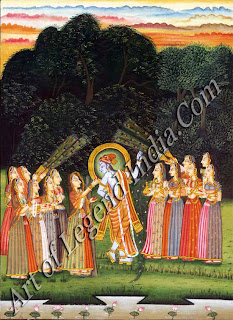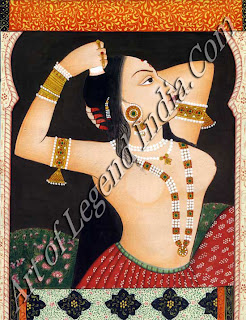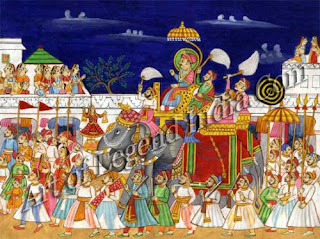 The dissolution of Mughal power
in the 18th century was matched by a similar decline at the courts of
Rajasthan. From the 1730s they were repeatedly overrun by the Marathas from the
south, who brought about a political and economic chaos that lasted until the
establishment of British suzerainty in 1818. Jaipur, which had been founded
close to Amber by the distinguished astronomer Raja Sawai Jai Singh
(1693-1743), is said to have reached depths of turpitude and intrigue
exceptional even in an age of general decadence. But painting continued under
its own inherent momentum. The Jaipur artists were much influenced by the hard
contemporary style of Delhi and Lucknow. Even so, a hackneyed subject of a lady
at her toilet could be transformed into a classically Rajput image by the
accentuated outline drawing of the face and figure and the contrast of
unmodelled flesh and background areas with the detail of jewellery, textile
patterns and a flower gardefik A more ebullient late phase of Rajasthani
painting occurred at Kotah under Rao Ram Singh (1827-65), who is seen passing
in procession through a bazaar, entertained as he rides by a nautch girl
supported on his elephant's tusks If this picture lacks the kinetic force of
the earlier elephant fight, it still has much charm and panache. Already,
however, a harsh synthetic green colour is in use. During the second half of
the-19th century traditional painting either succumbed or was
radically changed by the impact of Western techniques and the sensational art
of photography.
The dissolution of Mughal power
in the 18th century was matched by a similar decline at the courts of
Rajasthan. From the 1730s they were repeatedly overrun by the Marathas from the
south, who brought about a political and economic chaos that lasted until the
establishment of British suzerainty in 1818. Jaipur, which had been founded
close to Amber by the distinguished astronomer Raja Sawai Jai Singh
(1693-1743), is said to have reached depths of turpitude and intrigue
exceptional even in an age of general decadence. But painting continued under
its own inherent momentum. The Jaipur artists were much influenced by the hard
contemporary style of Delhi and Lucknow. Even so, a hackneyed subject of a lady
at her toilet could be transformed into a classically Rajput image by the
accentuated outline drawing of the face and figure and the contrast of
unmodelled flesh and background areas with the detail of jewellery, textile
patterns and a flower gardefik A more ebullient late phase of Rajasthani
painting occurred at Kotah under Rao Ram Singh (1827-65), who is seen passing
in procession through a bazaar, entertained as he rides by a nautch girl
supported on his elephant's tusks If this picture lacks the kinetic force of
the earlier elephant fight, it still has much charm and panache. Already,
however, a harsh synthetic green colour is in use. During the second half of
the-19th century traditional painting either succumbed or was
radically changed by the impact of Western techniques and the sensational art
of photography.
By the 15705 Akbar had
succeeded in subduing nearly all the major Rajput kingdoms and in winning over
their rulers by giving them command of his armies and marrying into their
families: his chief queen and Jahangir's mother was a Rajput princess from Amber.
Spending long periods at the imperial court, the rajas and their sons naturally
began to imitate its customs and fashions. From around i600 sonic of them
employed artists trained in the Mughal studio, who worked in a hybrid style of
Hindu manuscript illustration which is usually called Popular Mughal. Later in
the 17th century some of the rajas were able to employ more accomplished
artists, skilled in the portrait styles of the Jahangir and Shah jahan periods.
These and subsequent waves of Mughal influence had varying but sometimes
profound effects on the local schools of Rajasthan and Central India, each of
which assimilated the new conventions in differing degrees to their existing
traditions, as represented for example by Bhairavi ragini.
The closest continuation of the
pre-Mughal style appears in the boldly simplified designs and colour schemes
used in the schools of Malwa and Bundclkhand. In a typical ragatnala picture,
Bhairava raga is depicted in the form of Krishna conversing with a lady in a pavilion
flanked by stylised flowering trees. The primitive expressive power of this
style is scarcely affected by the Popular Mughal influence that was reaching
the Rajasthani courts. It may be contrasted with a version of the same subject,
in this case more correctly conceived: as Shiva (of whom Bhairava, 'the
Terrible: is an epithet), who sits under a flayed elephant skin in a royal
palace attended by maids. This picture belongs to a series painted at Chunar,
near Bermes, in 1591 by artists trained iii Akbar's studio. Its judicious use
of figural modelling and spatial recession as well as the decorative tile-work
and arabesque borders of the painting are all Akbari features. The series must
have belonged at an early date to the rulers of Bundi, whose imperial service
brought them at one stage to Chunar, for its iconography established a norm for
later Bundi ragamalas. At other courts manuscript illustration was
similarlymodified by a more dilute Popular Mughal influence; (A version of
Kakubha ragini, personified as a lovelorn lady whose charms pacify the wild
blackbuck, is composed in an archaic series of registers and combines
old-fashioned landscape conventions with elegantly attenuated figure drawing
and a row of stylised Mughal flowers at the top.
During the second half of the 17th
century portraiture and genre scenes of the Mughal type were introduced at all
the main courts, with varying degrees of adaptation to the Rajput vision. Jaswant
Singh of Jodphur, who spent much of his life in the imperial service, chose to
patronise work in a strongly Mughal style, as seen in an unfinished drawing of
a durbar scene. However, in later painting at Jodphur, as elsewhere, this
influence became muted and indigenous linear rhythms and colour schemes
reasserted them-selves. Artists at the court of Kotah in particular brought a
unique linear verve to animal subjects such as hunts and elephant fights. The
tumultuous energy of the colliding beasts is evoked by fluid or densely
swirling passages of line and dramatic distortions of anatomical form. This
powerfully empathetic rendering can be contrasted with the flat decorativeness
of the Jain painter's elephant, or with die rich colour effect and strictly
naturalistic modelling of the Deccani and Mughal examples.
Even at the desert-locked court
of Bikaner, where in the late 17th century migrant Muslim artist families had
worked in a Mughal-derived style with some Deccani elements, Rajput conventions
re-appeared within one or two generations. A picture of the autumn month of Karttik,
from a Barahmasa series illustrating the activities of noble lovers during the
twelve months of the year, displays a formalised composition, elongated figures
and vague spatial relationships. A noble and lady stand before a pavilion with
a bed-chamber; another bed is prepared on the roof. In the back-ground a couple
play at chaupar, men bathe and women draw auspicious rangoli patterns on the
ground:
A later and more lyrical fusion
of the ardent sentiments of Hindu devotional poetry with the polished 18th
century Mughal style occurred at Kishangarh, whose ruler, Savant Singh
(1748-57), was himself air accomplished poet. The love sports of Krishna and
Radha were depicted in palace and lakeside settings similar to those of
Kishangarh, and may have been based on Savant Singh's love for a dancer at his
court, with whom he eventually retired to the holy city of Brindabanput the
perilously mannered sweetness of the Kishangarb style soon turned to a cloying
sentimentality.
The Ranas of Mewar, who had
long been regarded as the premier ruling family and the custodians of Rajput
honour, had been the last to capitulate to the Mughals. During the 17th
century they continued their earlier traditions of manuscript illustration in a
bright and forceful style modified by some Popular Mughal influence. But from
the early i8th century the Udaipur artists' best work consisted of ambitious
and original paintings of court life: portraits, durbars, processions, hunts,
religious festivals and zenana scenes, often of unusually large size and full
of anecdotal detail. Some of the better compositions made use of architectural
settings adapted from the palace buildings at Udaipur. Individual portraits of
the Mughal type, showing an isolated figure seated or standing in profile, were
often wooden, but a curious study of an obese courtier in a striped pink pyjama
has a keen satirical edge.
 The dissolution of Mughal power
in the 18th century was matched by a similar decline at the courts of
Rajasthan. From the 1730s they were repeatedly overrun by the Marathas from the
south, who brought about a political and economic chaos that lasted until the
establishment of British suzerainty in 1818. Jaipur, which had been founded
close to Amber by the distinguished astronomer Raja Sawai Jai Singh
(1693-1743), is said to have reached depths of turpitude and intrigue
exceptional even in an age of general decadence. But painting continued under
its own inherent momentum. The Jaipur artists were much influenced by the hard
contemporary style of Delhi and Lucknow. Even so, a hackneyed subject of a lady
at her toilet could be transformed into a classically Rajput image by the
accentuated outline drawing of the face and figure and the contrast of
unmodelled flesh and background areas with the detail of jewellery, textile
patterns and a flower gardefik A more ebullient late phase of Rajasthani
painting occurred at Kotah under Rao Ram Singh (1827-65), who is seen passing
in procession through a bazaar, entertained as he rides by a nautch girl
supported on his elephant's tusks If this picture lacks the kinetic force of
the earlier elephant fight, it still has much charm and panache. Already,
however, a harsh synthetic green colour is in use. During the second half of
the-19th century traditional painting either succumbed or was
radically changed by the impact of Western techniques and the sensational art
of photography.
The dissolution of Mughal power
in the 18th century was matched by a similar decline at the courts of
Rajasthan. From the 1730s they were repeatedly overrun by the Marathas from the
south, who brought about a political and economic chaos that lasted until the
establishment of British suzerainty in 1818. Jaipur, which had been founded
close to Amber by the distinguished astronomer Raja Sawai Jai Singh
(1693-1743), is said to have reached depths of turpitude and intrigue
exceptional even in an age of general decadence. But painting continued under
its own inherent momentum. The Jaipur artists were much influenced by the hard
contemporary style of Delhi and Lucknow. Even so, a hackneyed subject of a lady
at her toilet could be transformed into a classically Rajput image by the
accentuated outline drawing of the face and figure and the contrast of
unmodelled flesh and background areas with the detail of jewellery, textile
patterns and a flower gardefik A more ebullient late phase of Rajasthani
painting occurred at Kotah under Rao Ram Singh (1827-65), who is seen passing
in procession through a bazaar, entertained as he rides by a nautch girl
supported on his elephant's tusks If this picture lacks the kinetic force of
the earlier elephant fight, it still has much charm and panache. Already,
however, a harsh synthetic green colour is in use. During the second half of
the-19th century traditional painting either succumbed or was
radically changed by the impact of Western techniques and the sensational art
of photography.
Writer – Andrew Topsfield
Subscribe to:
Post Comments (Atom)














0 Response to "Rajput painting in rajasthan and central india"
Post a Comment